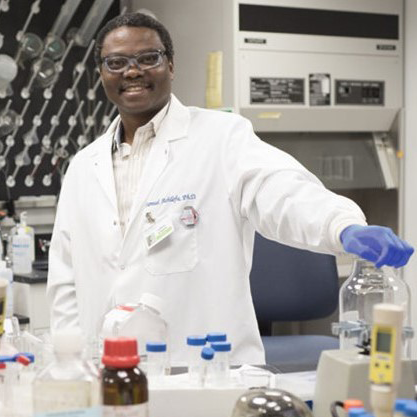Samuel Achilefu
Washington University in St Louis, USAFor pioneering the development of near infrared molecular imaging and image-guided surgical resection of cancer, and exceptional leadership and service to the biomedical optics community.

In retrospect, says Samuel Achilefu, it was natural that he grew up to be a scientist, where he could use his knowledge of optics and chemistry to help surgeons visualize cancer cells in the human body. But while he was growing up in the midst of war and upheaval, his future path was far from obvious.
Achilefu, the Michel M. Ter-Pogossian professor of radiology at the medical school of Washington University in St. Louis (WUSTL), USA, was born in northern Nigeria. Before he was old enough to start school, civil war broke out, and he and his family fled to Igbo region in eastern Nigeria, the ancestral homeland of the family's Igbo tribe. Traumatized by the unrest, the young Achilefu found a refuge in schooling, reading books and building toys from found objects. His father encouraged him to read beyond what was taught in schools and “truly believed that knowledge is power,” he says.
In high school, Achilefu excelled in all his subjects and also enjoyed literature classes, but his curiosity about the natural world kept bringing him back to the scientific path. At the university level, he won a coveted fellowship for graduate study in France. There he ran into a challenge: he was fluent in Igbo and English, but the classes at the University of Nancy were taught in French. Fortunately, many of the books and journal articles were in English, so at the beginning he would read them carefully and then try to wrap his head around the corresponding material in French. Ultimately, in 1991 Achilefu earned his Ph.D. in molecular and materials chemistry with distinction.
Achilefu has fond memories of his doctoral adviser, the late Claude Selve. “He was an amazing guy, who would sit down with you in the evening, go through what you've done for the day, ask you questions, and shed light on the problems that you may be trying to solve,” he says. To people who are still seeking a mentor, Achilefu advises: “Know who you are. Some people like to be micromanaged, to be told what to do, and then they do it, they come back and they ask for the next thing. And others like to explore, all they need is a general idea and the potential impact of a project before launching into a new project.”
For his first postdoctoral job, Achilefu spent two years studying physiological oxygen transport methods at Oxford University in the UK. Hemoglobin's ability to pick up oxygen in the lungs and selectively release it elsewhere in the body fascinated him, as he and his colleagues sought to develop new molecules that could perform similar transport in a blood substitute. At the end of his fellowship in 1993, Achilefu was recruited to St. Louis, Missouri, where he's been ever since.
Recently, Achilefu and his WUSTL collaborators have developed special eyewear that helps surgeons “see” cancer cells in tissue. The enabling component of the prototype viewing system is a new dye that emits light at near-infrared frequencies. The dye molecules latch onto cancer cells but not their normal counterparts. A miniaturized camera detects the near-infrared radiation from the dye, and the lightweight glasses reveal the cancer cells to the surgeon's eye. “During surgery, the entire tumor mass will light up. Any residual tumor left behind after removing the large tumor mass will become the brightest tissue around there, so you can remove the small lesions that you wouldn't have seen before,” he says.
Achilefu says he got the idea for the cancer-spotting glasses from discussions with a WUSTL surgical fellow, who pointed out how difficult it is to find some types of cancer cells among other tissues. The two biggest challenges in the project, he adds, were making the glasses light enough that surgeons would want to wear them and processing the camera's images without lag time. Achilefu's team is working with surgeons to optimize the prototype system.
A 1998 OSA topical meeting on biomedical optics was the first optics conference Achilefu had ever attended, and he was thrilled to discover the community of researchers in the field. One of the ways he has given back to the community has been to serve as the founding faculty adviser of WUSTL's student imaging chapter, WU Spectra. As he tells students: “By exploring beyond what we are teaching you today, you can break grounds that nobody could have imagined possible today.”
Profile written by Patricia Daukantas
